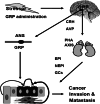Gastrin-releasing peptide links stressor to cancer progression
- PMID: 20140628
- PMCID: PMC11827830
- DOI: 10.1007/s00432-010-0766-2
Gastrin-releasing peptide links stressor to cancer progression
Abstract
Introduction: Gastrin-releasing peptide (GRP) plays an important role in cancer growth and metastasis; however, the mechanisms of how GRP affects cancer progression are not well understood. Recent studies revealed that chronic stress is a major risk factor for cancer progression, and this effect may be mediated by GRP. In this review, we will discuss the mechanisms and implications of GRP linking stressor to cancer progression.
Materials and methods: We retrieved the studies of the relationship between GRP, stress and cancers through PubMed using systematic methods to search, select, and evaluate the findings.
Results: The results suggested that GRP can mediate the effects of stress on cancers at systemic, tissue and cellular levels: Stress elicits the secretion of GRP in the brain and GRP in turn activates the stress response pathways resulting in an elevation of stress hormones and GRP in the plasma and tissues. GRP in synergy with stress hormones stimulates the growth and invasion of cancer cells by suppressing the anti-tumor immune function and directly activating the pro-proliferative and pro-migratory signaling pathways in cancer cells.
Conclusion: GRP is a multi-functional peptide, which acts as a stress mediator as well as a growth factor linking stressor to cancer progression. GRP and its high-affinity receptor are useful targets for the diagnosis and treatment of cancers.
Figures


References
-
- Abujamra AL, Almeida VR, Brunetto AL, Schwartsmann G, Roesler R (2009) A gastrin-releasing peptide receptor antagonist stimulates neuro2a neuroblastoma cell growth: prevention by a histone deacetylase inhibitor. Cell Biol Int 33(8):899–903 - PubMed
-
- Algazi M, Plu-Bureau G, Flahault A et al (2006) Is beta-blocker treatment associated with a decrease in the risk of cancer. Lett Drug Des Discov 3(9):653–661
-
- Ananias HJ, van den Heuvel MC, Helfrich W, de Jong IJ (2009) Expression of the gastrin-releasing peptide receptor, the prostate stem cell antigen and the prostate-specific membrane antigen in lymph node and bone metastases of prostate cancer. Prostate 69(10):1101–1108 - PubMed
Publication types
MeSH terms
Substances
LinkOut - more resources
Full Text Sources

